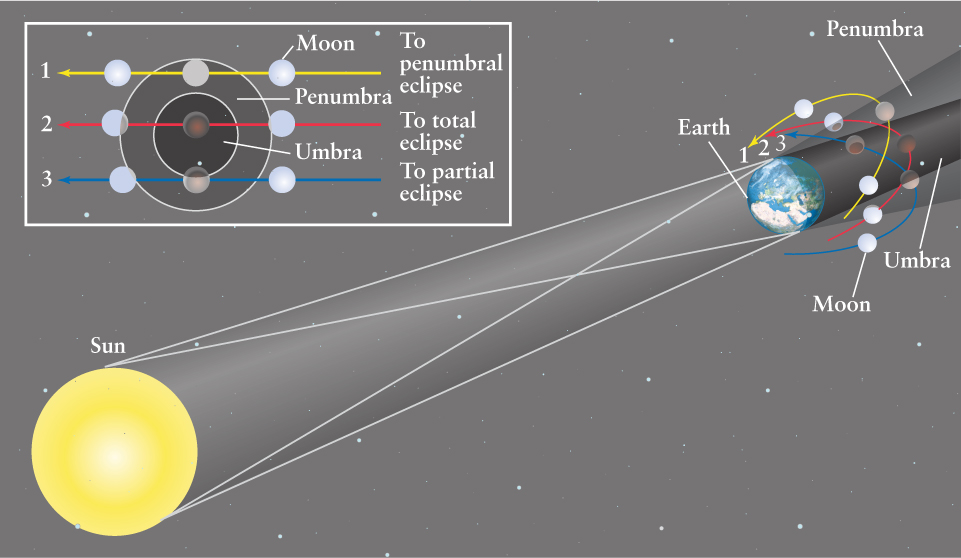3-4 The character of a lunar eclipse depends on the alignment of the Sun, Earth, and Moon
The Sun’s tenuous outer atmosphere is revealed during a total solar eclipse
The character of a lunar eclipse depends on exactly how the Moon travels through Earth’s shadow. As Figure 3-8 shows, the shadow of Earth has two distinct parts. To picture how the Moon’s surface would be illuminated, imagine an observer on the Moon as the Moon passes through the shadow. In the umbra, no portion of the Sun’s surface can be seen from the Moon: This is the darkest part of the shadow. On the other hand, a portion of the Sun’s surface is visible in the penumbra, which therefore is not quite as dark. Most people notice a lunar eclipse only if the Moon passes into Earth’s umbra. As this umbral phase of the eclipse begins, a bite appears to have been taken out of the Moon.

The inset in Figure 3-8 shows the different ways in which the Moon can pass into Earth’s shadow. When the Moon passes through only Earth’s penumbra (Path 1), we see a penumbral eclipse. During a penumbral eclipse, Earth blocks only part of the Sun’s light and so none of the lunar surface is completely shaded. Because the Moon still looks full but only a little dimmer than usual, penumbral eclipses are easy to miss. If the Moon travels completely into the umbra (Path 2), a total lunar eclipse occurs. If only part of the Moon passes through the umbra (Path 3), we see a partial lunar eclipse.
If you were on the Moon during a total lunar eclipse, the Sun would be hidden behind Earth. But some sunlight would be visible through the thin ring of atmosphere around Earth, just as you can see sunlight through a person’s hair if they stand with their head between your eyes and the Sun. As a result, a small amount of light reaches the Moon during a total lunar eclipse, and so the Moon does not completely disappear from the sky as seen from Earth. Most of the sunlight that passes through Earth’s atmosphere is red, and thus the eclipsed Moon glows faintly in reddish hues, as Figure 3-9 shows. (We’ll see in Chapter 5 how our atmosphere causes this reddish color.)

A Total Lunar Eclipse This sequence of nine photographs was taken over a 3-hour period during the lunar eclipse of January 20, 2000. The sequence, which runs from right to left, shows the Moon moving through Earth’s umbra. During the total phase of the eclipse (shown in the center), the Moon has a distinct reddish color.
Lunar eclipses occur at full moon, when the Moon is directly opposite the Sun in the sky. Hence, a lunar eclipse can be seen at any place on Earth where the Sun is below the horizon (that is, where it is nighttime). A lunar eclipse has the maximum possible duration if the Moon travels directly through the center of the umbra. The Moon’s speed through Earth’s shadow is roughly 1 kilometer per second (3600 kilometers per hour, or 2280 miles per hour), which means that totality—the period when the Moon is completely within Earth’s umbra—can last for as long as 1 hour and 42 minutes.
On average, two or three lunar eclipses occur in a year. Table 3-1 lists all nine lunar eclipses from 2012 to 2015. Of all lunar eclipses, roughly one-third are total, one-third are partial, and one-third are penumbral.
| Date | Type | Where visible | Duration of totality (h = hours, m = minutes) |
|---|---|---|---|
| 2012 June 4 | Partial | Asia, Australia, Pacific, Americas | — |
| 2012 Nov 28 | Penumbral | Europe, eastern Africa, Asia, Australia, Pacific, North America | — |
| 2013 Apr 25 | Penumbral | Europe, Africa, Asia, Australia | — |
| 2013 May 25 | Penumbral | Americas, Africa | — |
| 2013 Oct 18 | Penumbral | Americas, Europe, Africa, Asia | — |
| 2014 Apr 15 | Total | Australia, Pacific, Americas | 01h 18m |
| 2014 Oct 08 | Total | Asia, Australia, Pacific, Americas | 59m |
| 2015 Apr 04 | Total | Asia, Australia, Pacific, Americas | 5m |
| 2015 Sep 28 | Total | East Pacific, Americas, Europe, Africa, western Asia | 1h 12m |
| Eclipse predictions by Fred Espenak, NASA/Goddard Space Flight Center. | |||
CONCEPT CHECK 3-7
Is it possible to have a total lunar eclipse without a penumbral eclipse?
No. Before the Moon passes into the full shadow (the umbra), where the Sun is completely blocked by Earth, the Moon must pass through the penumbra where only part of the Sun is blocked. This is illustrated by Path 2 in Figure 3-8.